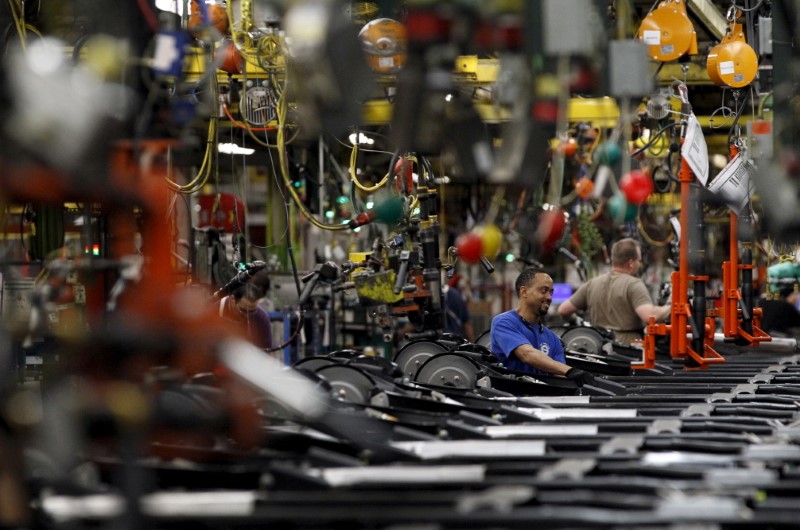By Lucia Mutikani
WASHINGTON (Reuters) - U.S. factory activity accelerated to more than a two-year high in January amid sustained gains in new orders and raw material costs, pointing to a recovery in manufacturing as domestic demand strengthens and the drag from low oil prices ebbs.
Other data on Wednesday showed private employers boosted hiring last month. While construction spending slipped in December, the underlying trend remained strong. The signs of momentum in the economy at the start of the year came as the Federal Reserve's policy-setting committee met for a second day.
The U.S. central bank, which has forecast three rate hikes this year, is not expected to raise rates when the meeting ends later on Wednesday. The Fed hiked its benchmark overnight interest rate in December to a range of 0.50 percent to 0.75 percent.
"The economy is off to the races with the wind at its back. The Fed will lift rates three times in 2017 for sure, and maybe they might need to add a rate hike or start the year earlier with a policy firming in March," said Chris Rupkey, chief economist at MUFG Union Bank in New York.
The Institute for Supply Management (ISM) said its index of national factory activity increased 1.5 percentage points to a reading of 56.0 last month, the highest since November 2014 when oil prices started collapsing.
A reading above 50 indicates an expansion in manufacturing, which accounts for about 12 percent of the U.S. economy. Some of the increase likely reflects a surge in business confidence following last November's election of Donald Trump as president.
Trump has pledged to cut taxes and reduce regulations. The business mogul-turned politician, who was sworn in as president on Jan. 20, has yet to offer more details about any fiscal stimulus package.
Manufacturers' comments on business conditions last month ranged from "good" to "stronger." Some described demand as "very" steady and others reported that sales bookings were "exceeding expectations."
The ISM's production sub-index increased 2.0 percentage points and a gauge of new orders edged up 0.1 percentage point, reaching its highest level in just over two years.
A measure of factory employment jumped 3.3 percentage points to its highest level since August 2014, suggesting factory payrolls likely rose in January for a second straight month.
Manufacturers reported paying more for raw materials. That was the 11th consecutive monthly increase, indicating inflation pressures at the factory gate could be building up. The ISM's prices index increased 3.5 percentage points in January to its highest level since May 2011.
"If higher prices in the goods-producing sector were sustained, this would likely help reassure Fed officials that inflation will reach and maintain its two percent target," said John Silvia, chief economist at Wells Fargo (NYSE:WFC) Securities in Charlotte, North Carolina.
"However, the strong dollar will likely help keep a lid on inflation."
MANUFACTURING RECOVERING
A collapse in oil prices in 2015 and a surge in the dollar weighed on manufacturing for much of last year, with most of the pain coming through sharp cutbacks in business spending on equipment. Oil prices have since risen above $50 per barrel, lifting some of the fog off manufacturing.
The manufacturing rebound was also underscored by a separate survey on Wednesday from data firm Markit.
The government reported last Friday that business spending on equipment increased at a 3.1 percent annualized rate in the fourth quarter, the first rise in over a year.
January's data so far suggests that the economy is poised for an acceleration after gross domestic product increased at a 1.9 percent annualized rate in the fourth quarter. The deceleration from the third quarter's brisk 3.5 percent pace reflected a wider trade deficit.
The dollar was trading higher against a basket of currencies, while prices for U.S. government bonds fell. U.S. stocks were marginally lower, having surrendered earlier gains.
Separately on Wednesday, the ADP National Employment Report showed private employers added 246,000 jobs in January, up from 151,000 in December. The report, jointly developed with Moody's Analytics, came ahead of the Labor Department's more comprehensive employment report on Friday, which includes both public and private sector payrolls.
The ADP report has a spotty record predicting the private payrolls component of the employment report because of methodology differences. Still, economists said the ADP report and the jump in the factory jobs measure of the ISM survey raised the possibility that January nonfarm payrolls could beat expectations.
"While we wouldn't dismiss the strength of the ADP number entirely, we would treat it with some caution, particularly in January," said Paul Ashworth, chief U.S. economist at Capital Economics in Toronto.
According to a Reuters survey of economists, nonfarm employment probably rose by 175,000 jobs last month, picking up from the 156,000 jobs added in December.
A third report from the Commerce Department showed construction spending slipped 0.2 percent in December after shooting up 0.9 percent in November. Construction spending increased 4.2 percent from December 2015.
